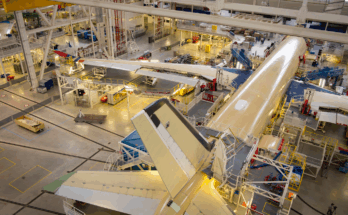By Ray Jaworowski, Senior Aerospace Analyst, Forecast International.
Forecast International predicts that a total of 4,040 regional aircraft will be produced by manufacturers during the 10-year period from 2015 through 2024. The total includes both regional jets and regional turboprop airliners. The value of this production is estimated at $136.1 billion in constant 2015 U.S. dollars.
The regional aircraft market is on the upswing. Production of regional aircraft rose by almost 30 percent in the 2013-2014 timeframe. The next several years will see continued market growth, though at a more subdued rate. We expect yearly production to flatten out somewhat in 2015 and 2016, before more robust growth kicks in during the 2017-2020 timeframe.
The production growth will largely be due to the service entry and initial production ramp-ups of new jetliners such as the Bombardier CS100, the Embraer E2 family, and the Mitsubishi Regional Jet (MRJ). Customers for these large-capacity regional jets will be found not only among regional airlines, but also within the ranks of major network airlines and low-fare carriers.
Scope clauses in pilot contracts remain a limiting factor in the large North American market, according to the study. With a minor exception for a handful of existing 86-seaters flown by American Airlines/US Airways partners, scope clauses at all three U.S. legacy carriers prohibit their regional partners from operating any aircraft larger than 76 seats. The next round of scope liberalization could keep the 76-seat limit in place, but might raise the accompanying 86,000-pound limit in maximum takeoff weight, which is found in all three contracts. Raising the weight limit would permit new aircraft such as the Embraer E175-E2 and Mitsubishi MRJ90, which exceed this weight restriction, to be operated in 76-passenger seating layouts.
Sales of regional turboprops have been strong in recent years, as high fuel prices and a need for carriers to reduce operating costs have driven demand for these aircraft. Recent steep declines in fuel prices, though, are sure to cool off turboprop demand to some extent, but a rebound in fuel costs would restore some of the lost momentum. Meanwhile, ATR and Bombardier have each been exploring the possibility of developing a 90-seat turboprop, but the new era of low fuel prices may be resulting in some hesitation in proceeding.
Our market share projections indicate that, based on unit production, Embraer, ATR, Bombardier, and new entrant Mitsubishi will be the leading regional aircraft manufacturers during the 2015-2024 forecast timeframe. Embraer is projected to build 910 regional jetliners during the period. ATR is expected to produce 836 regional turboprops. Bombardier, which produces both jets and turboprops, is forecast to build 696 regional aircraft. Mitsubishi is projected to produce 538 regional jets.
Forecast International’s Civil Aircraft Forecast covers all facets of the fixed-wing commercial and private aviation industry. It includes more than 70 detailed reports, complete with production forecasts on individual civil aircraft families. Four Market Segment Analyses provide in-depth examination of the markets for Large Commercial Jet Transports, Regional Aircraft, Business Jets, and General Aviation/Utility Aircraft.
A military history enthusiast, Richard began at Forecast International as editor of the World Weapons Weekly newsletter. As the Internet grew in importance as a research tool, he helped design the company's Forecast Intelligence Center and currently coordinates the EMarket Alert newsletters for clients. Richard also manages social media efforts, including two new blogs: Defense & Security Monitor, covering defense systems and international issues, and Flight Plan, which focuses on commercial aviation and space systems. For over 30 years, Richard has authored the Defense & Aerospace Companies, Volume I (North America) and Volume II (International) services. The two books provide detailed data on major aerospace and defense contractors. He also edits the International Contractors service, a database that tracks all the contractors involved in the programs covered in the FI library. More recently he was appointed Manager, Information Services Group (ISG), a new unit that encompasses developing outbound content for both Forecast International and Military Periscope.




